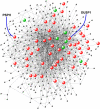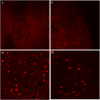Transcriptomic analysis identifies phosphatases as novel targets for adenotonsillar hypertrophy of pediatric obstructive sleep apnea
- PMID: 20093640
- PMCID: PMC2874453
- DOI: 10.1164/rccm.200909-1398OC
Transcriptomic analysis identifies phosphatases as novel targets for adenotonsillar hypertrophy of pediatric obstructive sleep apnea
Abstract
Rationale: Obstructive sleep apnea (OSA) is a highly prevalent disorder in children, in which enlarged adenotonsillar tissues (AT) play a major pathophysiologic role. Mechanisms leading to the proliferation and hypertrophy of AT in children who subsequently develop OSA remain unknown, and surgical extirpation of AT is associated with potential morbidity and mortality.
Objectives: We hypothesized that a computationally based analysis of gene expression in tonsils from children with OSA and children with recurrent tonsillitis without OSA can identify putative mechanistic pathways associated with tonsillar proliferation and hypertrophy in OSA.
Methods: Palatine tonsils from children with either polysomnographically documented OSA or recurrent infectious tonsillitis were subjected to whole-genome microarray and functional enrichment analyses followed by significance score ranking based on gene interaction networks. The latter enabled identification and confirmation of a candidate list of tonsil-proliferative genes in OSA.
Measurements and main results: In vitro studies using a mixed tonsil cell culture system targeting one of these candidates, phosphoserine phosphatase, revealed that it was more abundantly expressed in tonsils of children with OSA, and that pharmacological inhibition of phosphoserine phosphatase led to marked reductions in T- and B-lymphocyte cell proliferation and increased apoptosis.
Conclusions: A systems biology approach revealed a restricted set of candidate genes potentially underlying the heightened proliferative properties of AT in children with OSA. Furthermore, functional studies confirm a novel role for protein phosphatases in AT hypertrophy, and may provide a promising strategy for discovery of novel, nonsurgical therapeutic targets in pediatric OSA.
Figures





Similar articles
-
A mixed cell culture model for assessment of proliferation in tonsillar tissues from children with obstructive sleep apnea or recurrent tonsillitis.Laryngoscope. 2009 May;119(5):1005-10. doi: 10.1002/lary.20147. Laryngoscope. 2009. PMID: 19266584 Free PMC article.
-
Genome-wide gene expression profiling in children with non-obese obstructive sleep apnea.Sleep Med. 2009 Jan;10(1):75-86. doi: 10.1016/j.sleep.2007.11.006. Epub 2008 Feb 7. Sleep Med. 2009. PMID: 18261956
-
Enzymatic study of tonsil tissue alkaline and acid phosphatase in children with recurrent tonsillitis and tonsil hypertrophy.Int J Pediatr Otorhinolaryngol. 2010 Jan;74(1):82-6. doi: 10.1016/j.ijporl.2009.10.022. Epub 2009 Nov 20. Int J Pediatr Otorhinolaryngol. 2010. PMID: 19931920
-
Use of intranasal corticosteroids in adenotonsillar hypertrophy.J Laryngol Otol. 2017 May;131(5):384-390. doi: 10.1017/S0022215117000408. Epub 2017 Feb 27. J Laryngol Otol. 2017. PMID: 28238295 Review.
-
Adenotonsillar microbiome: an update.Postgrad Med J. 2018 Jul;94(1113):398-403. doi: 10.1136/postgradmedj-2018-135602. Epub 2018 Jun 8. Postgrad Med J. 2018. PMID: 29884749 Review.
Cited by
-
Interfering Expression of Chimeric Transcript SEPT7P2-PSPH Promotes Cell Proliferation in Patients with Nasopharyngeal Carcinoma.J Oncol. 2019 Apr 1;2019:1654724. doi: 10.1155/2019/1654724. eCollection 2019. J Oncol. 2019. PMID: 31057610 Free PMC article.
-
Adenoid hypertrophy in children: a narrative review of pathogenesis and clinical relevance.BMJ Paediatr Open. 2023 Apr;7(1):e001710. doi: 10.1136/bmjpo-2022-001710. BMJ Paediatr Open. 2023. PMID: 37045541 Free PMC article. Review.
-
Intermittent hypoxia mobilizes bone marrow-derived very small embryonic-like stem cells and activates developmental transcriptional programs in mice.Sleep. 2010 Nov;33(11):1439-46. doi: 10.1093/sleep/33.11.1439. Sleep. 2010. PMID: 21102985 Free PMC article.
-
Alternatives to surgery in children with mild OSA.World J Otorhinolaryngol Head Neck Surg. 2021 May 29;7(3):228-235. doi: 10.1016/j.wjorl.2021.03.005. eCollection 2021 Jul. World J Otorhinolaryngol Head Neck Surg. 2021. PMID: 34430830 Free PMC article. Review.
-
Transcriptional landscape of bone marrow-derived very small embryonic-like stem cells during hypoxia.Respir Res. 2011 May 10;12(1):63. doi: 10.1186/1465-9921-12-63. Respir Res. 2011. PMID: 21569252 Free PMC article.
References
-
- Arens R, McDonough JM, Corbin AM, Rubin NK, Carroll ME, Pack AI, Liu J, Udupa JK. Upper airway size analysis by magnetic resonance imaging of children with obstructive sleep apnea syndrome. Am J Respir Crit Care Med 2003;167:65–70. - PubMed
Publication types
MeSH terms
Substances
Grants and funding
LinkOut - more resources
Full Text Sources
Medical
Molecular Biology Databases

